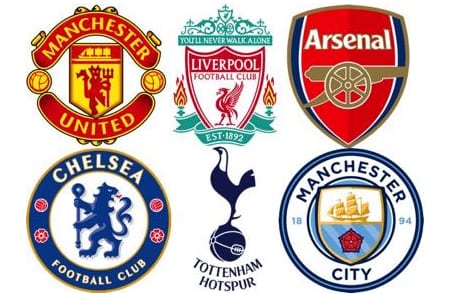- Take Newcastle United as a prime example. Since the club’s takeover by the Saudi Public Investment Fund in 2021, they have quickly become one of the most well-funded teams in the world. Eddie Howe’s tactical acumen has transformed the team from relegation candidates into a legitimate top-six challenger, regularly qualifying for European competition. With a wealth of resources at their disposal,
The English Premier League (EPL) has long been defined by its "Big Six" clubs—Manchester United, Liverpool, Manchester City, Chelsea, Arsenal, and Tottenham Hotspur—who, for the better part of two decades, have ruled the roost both domestically and in European competitions.
However, recent seasons have suggested that the dominance of this traditional elite is beginning to wane. Clubs like Newcastle United, Aston Villa, Brighton, and even Brentford are challenging the status quo, raising questions about the future of EPL rivalries and whether the "Big Six" will remain the undisputed heavyweights.
At the top of the Premier League, Manchester City’s financial muscle and Pep Guardiola’s tactical brilliance have seen them dominate in recent years, alongside Liverpool, who experienced their own period of supremacy under Jürgen Klopp. However, two things are now clear: Manchester City’s potential dominance faces both external and internal challenges, and clubs previously seen as mid-tier or relegation-threatened are no longer mere pushovers.
Take Newcastle United as a prime example. Since the club’s takeover by the Saudi Public Investment Fund in 2021, they have quickly become one of the most well-funded teams in the world. Eddie Howe’s tactical acumen has transformed the team from relegation candidates into a legitimate top-six challenger, regularly qualifying for European competition. With a wealth of resources at their disposal,
Newcastle's ability to attract top-tier talent and establish themselves as a genuine contender marks a shift in the traditional power structure of the league.
Read More
Similarly, Aston Villa under Unai Emery has undergone a revival, with a strong squad now capable of securing European football for the upcoming seasons. The club has strengthened its recruitment strategy, focusing on bringing in quality talent, including players like Moussa Diaby and Pau Torres, which has seen them overtake more historically successful clubs in terms of consistency and competitiveness. Villa’s ascendancy, much like Newcastle’s, signals a changing of the guard.
One of the most impressive stories in recent EPL history is the rise of Brighton & Hove Albion. Historically a mid-table team at best, Brighton’s consistent upward trajectory is the result of a perfect storm of smart recruitment, innovative coaching, and financial prudence.
Under the guidance of Graham Potter (and now Roberto De Zerbi), Brighton’s tactical play has been lauded as some of the most progressive in the league. The club’s focus on data-driven recruitment, scouting undervalued players from across Europe, has allowed them to sign bargains like Moisés Caicedo, Leandro Trossard, and Alexis Mac Allister, all of whom have gone on to play at higher-profile clubs.
Brighton’s progression on the field has been matched by a savvy approach off it. In 2021, Brighton made a breakthrough with a reported £250 million in revenue, a figure that reflects their smart business model, which prioritizes long-term sustainability over short-term financial excess. With a stadium regularly filled, a growing fanbase, and a consistent output of top-tier talent, Brighton now competes for European spots with a team that is both tactically well-drilled and financially stable.
This progression highlights that clubs outside of the "Big Six" can no longer be seen as anomalies or flash-in-the-pan successes. They represent a new breed of Premier League teams with the infrastructure and resources to challenge the traditional top clubs.
The reason the "Big Six" no longer dominate in the same way is simple: the footballing landscape has changed. Financially, many of the traditionally smaller clubs have now been able to compete on a more equal footing, thanks to the massive influx of cash from TV deals, sponsorships, and in some cases, wealthy ownerships. This means that clubs with a savvy strategy and a bit of luck can now rise through the ranks, challenging the established order.
Additionally, the EPL has seen an increase in competitive parity due to the expansion of scouting networks and better investment in youth development. Teams like Leicester City, who won the league in 2016, and now Newcastle and Aston Villa, represent a new kind of "club-building," where sustainability, smart recruitment, and tactical innovation outweigh the traditional advantage of bigger budgets.
While the "Big Six" will still maintain their place at the top for the foreseeable future, these newer teams are not just challenging for Champions League spots but are also shaping the future of English football by forcing the elite to evolve or risk being left behind.
If the Premier League continues to shift towards a more competitive and less top-heavy landscape, we could see a new set of rivalries emerge. Imagine a top-four battle between Manchester City, Newcastle, Liverpool, and Aston Villa, with Arsenal and Manchester United fighting for the last spot in the Champions League. These new rivalries, born from a more equal playing field, could elevate the intensity of the league even further, as clubs with new ambitions and fresh strategies push the established giants to their limits.
The rise of clubs like Brighton, Aston Villa, and Newcastle reflects the growing diversity and vibrancy of the Premier League. Rivalries between clubs that were previously distant and unlikely challengers could become the new norm. Clubs that were once considered "sleeping giants" or mid-table mediocrity are no longer content with simply staying afloat—they are now actively striving for greatness.
While the "Big Six" may still hold a financial and historical advantage in the Premier League, the rise of teams like Newcastle, Brighton, and Aston Villa signals that the dominance of these traditional powerhouses is under threat. The next decade of English football will likely see a more competitive and dynamic league, with more clubs pushing for a seat at the table. In this shifting landscape, the Premier League could evolve into an even more exciting and unpredictable competition, benefiting fans, clubs, and players alike.












